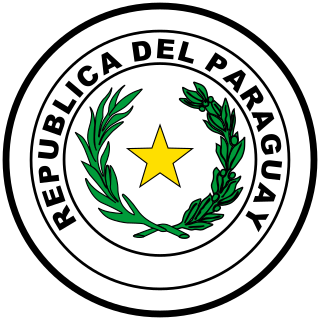
The Armed Forces of Paraguay officially the Armed Forces of the Nation consist of the Paraguayan army, Paraguayan navy and air force.

The Armed Forces of Uruguay consist of the National Army of Uruguay, the National Navy of Uruguay, and the Uruguayan Air Force. These three independent branches are constitutionally subordinate to the President of the Republic through the Minister of Defense. The government has trimmed the armed forces to about 16,800 for the Army; 6,000 for the Navy; and 3,000 for the Air Force. As of February 2003, Uruguay has more than 2,500 soldiers deployed on 12 UN Peacekeeping missions. The largest groups are in the Democratic Republic of the Congo and Haiti. There is also a 58-man contingent in the MFO in the Sinai.
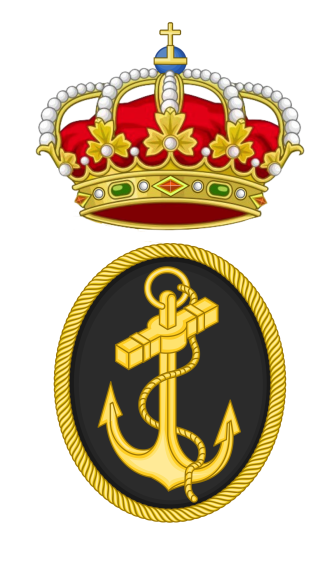
The Spanish Navy or officially, the Armada, is the maritime branch of the Spanish Armed Forces and one of the oldest active naval forces in the world. The Spanish Navy was responsible for a number of major historic achievements in navigation, the most famous being the discovery of America and the first global circumnavigation. For several centuries, it played a crucial logistical role in the expansion and consolidation of the Spanish Empire, and defended a vast trade network across the Atlantic Ocean between the Americas and Europe, and the Manila Galleon across the Pacific Ocean between the Philippines and the Americas.
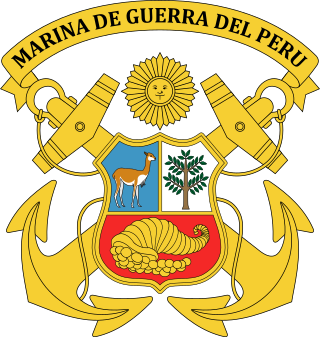
The Peruvian Navy is the branch of the Peruvian Armed Forces tasked with surveillance, patrol and defense on lakes, rivers and the Pacific Ocean up to 200 nautical miles from the Peruvian littoral. Additional missions include assistance in safeguarding internal security, conducting disaster relief operations and participating in international peacekeeping operations.
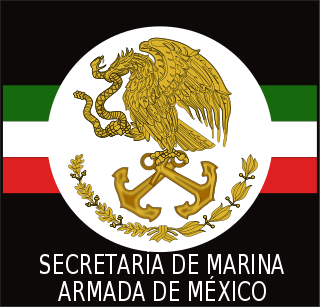
The Mexican Navy is one of the two independent armed forces of Mexico. The actual naval forces are called the Armada de México. The Secretaría de Marina (SEMAR) includes both the Armada itself and the attached ministerial and civil service. The commander of the Navy is the Secretary of the Navy, who is both a cabinet minister and a career naval officer.
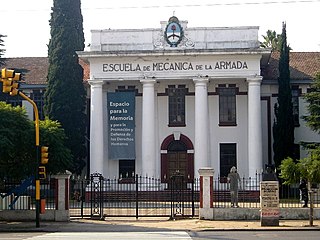
The Higher School of Mechanics of the Navy has gone through three major transformations throughout its history. Originally ESMA served as an educational facility of the Argentine Navy. The original ESMA was a complex located at 8151 Libertador Avenue, in the Autonomous City of Buenos Aires, in the barrio of Núñez. Additionally, It was the seat of U.T.3.3.2—Unidad de Tareas 2 of G.T.3.3 [es].

The Naval Military Academy, at Marín, Pontevedra, in north-western Spain, is a coeducational naval academy that educates officers for commissioning primarily into the Spanish Navy and Spanish Navy Marines.

The Marine Infantry is the naval infantry branch of the Spanish Navy responsible for conducting amphibious warfare. Fully integrated into the Spanish Navy's structure, the branch's history dates back to 1537 when Charles V, Holy Roman Emperor formed the Compañías Viejas del Mar de Nápoles, making it the oldest marine unit in existence.
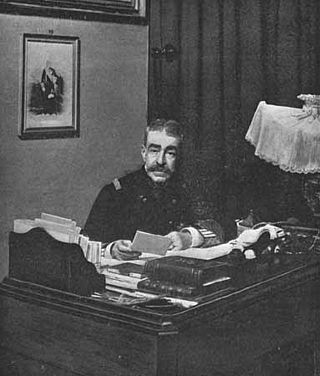
Segismundo Bermejo y Merelo was a Spanish Navy officer who served as chief of Staff of the Navy and Minister of the Navy during the Spanish–American War. He was most notable for his role in dispatching Pascual Cervera y Topete, in command of a squadron of four cruisers and three destroyers, to Cuba in May 1898. It set up the conditions for the Battle of Santiago de Cuba. Bermejo himself was forced to resign as Minister of the Navy after the defeat of the Spanish Pacific Squadron at the Battle of Manila Bay by the United States Navy, and died a year later.
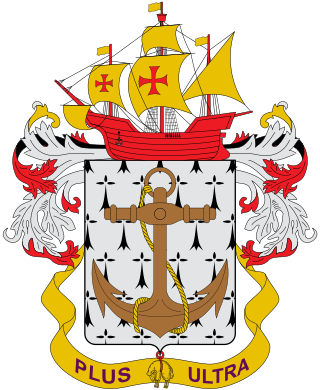
The Colombian Navy, officially the Colombian National Navy, also known as the "Armada Nacional" or just the "Armada" in Spanish, is the naval branch of the military forces of Colombia. The Navy is responsible for security and defence in the Colombian zones of both the Atlantic (Caribbean) and Pacific oceans, the extensive network of rivers inside the country, and a few small land areas under its direct jurisdiction.
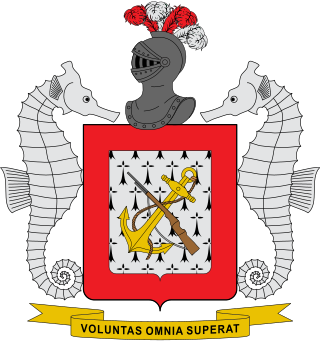
The Colombian Naval Infantry, also referred to as Colombian Marines, is the marine force of the Colombian National Armada. The 53,123-member Colombian Marine Infantry is organized into a single division with four brigades, each with several battalions plus numerous small security units.

The National Navy of Uruguay is a branch of the Armed Forces of Uruguay under the direction of the Ministry of National Defense and the commander in chief of the Navy.
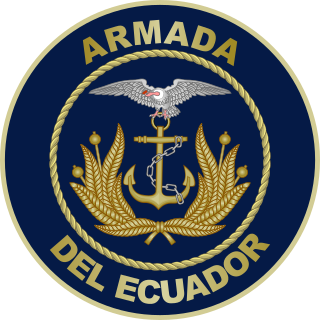
The Ecuadorian Navy is an Ecuadorian entity responsible for the surveillance and protection of national maritime territory and has a personnel of 9,400 men to protect a coastline of 2,237 km which reaches far into the Pacific Ocean. The vessels are identified by a ship prefix of B.A.E.: Buque de la Armada del Ecuador or L.A.E.: Lancha de la Armada del Ecuador.
The Chilean honours system provides a means for the Government of Chile to reward gallantry, achievement, or service, by both Chileans and non-citizens. The honours system consists of three types of award: orders, decorations and medals. Membership of an Order is conferred to recognise merit in terms of achievement and service. Decorations are conferred to recognise specific deeds of gallantry, bravery, distinguished or meritorious service. Medals are conferred to recognise long and/or valuable service and/or good conduct. Awards to non-citizens are usually only made where the gallantry, achievement or service has advanced Chilean interests in some way. The honours conferred by the Chilean Republic can be divided into two groups: civil and military. Military honours are conferred by the different branches of the Armed Forces of Chile. Civil honours are conferred by the President of Chile or, in some instances, by the government minister relevant to the particular honour.
The San Fernando Naval Museum is a naval museum located in San Fernando in the Province of Cádiz, Andalusia, Spain. Although a naval museum was called for as early as 28 September 1792. A museum was established in 1843, but the current museum was inaugurated on 27 March 1992, with the main purpose to promote the history of the presence of the Spanish Armada in the area.
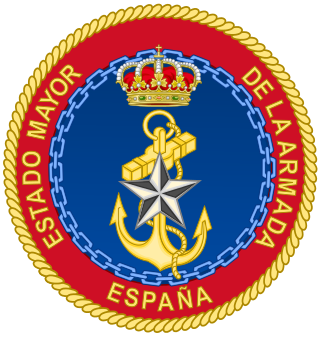
The Chief of Staff of the Navy or Admiral Chief of Staff of the Navy (AJEMA) is the highest-ranking military officer of the Spanish Navy that, under the authority of the Defence Minister, exercises command over the naval branch and, as such, is the principal military advisor to the Chief of the Defence Staff, the Minister of Defence, the Secretary of State for Defence, the Under-Secretary of Defence and the National Defence Council.
Zoilo Sánchez de Ocańa y Vieitiz was a Spanish Navy officer who served as the first Chief of Staff of the Navy from 14 July 1895 to 19 March 1896. As of 1869, he was a frigate captain on the war and navy section of the State Council. He was also made a Commander of the Order of Charles III in 1865, and in 1893 he had been awarded the Order of Naval Merit. It is likely that he was retired or died by the time the Spanish–American War broke out in 1898, as he was not present at a meeting of senior Spanish naval officers on 23 April 1898 that decided to send Admiral Pascual Cervera's squadron to Cuba.
Fernando Martínez de Espinosa y Echeverri was a Spanish Navy officer who served as Chief of Staff of the Navy from 19 March 1896 until 22 October 1896. In the summer of 1895 Espinosa had commanded the Spanish squadron that represented their country at the opening of the Kiel Canal from the Infanta Maria Teresa. During the Spanish–American War, he was present at a meeting of senior Spanish naval officers chaired by Segismundo Bermejo y Merelo, the minister of the navy at the time, on 23 April 1898. Espinosa supported the idea of sending Admiral Pascual Cervera y Topete's squadron from Cape Verde to the Spanish colonies in the Caribbean. This decision was adopted by the majority of the members which led to the Battle of Santiago de Cuba. Espinosa was made Commander of the Order of Charles III in 1882 and awarded the Grand Cross of the Royal and Military Order of Saint Hermenegild on 30 October 1889.
The military ranks and insignia of Chile are the military insignia used by the Chilean Armed Forces.














